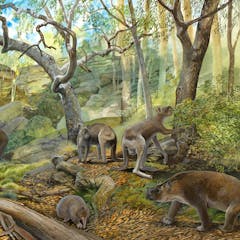
Articles on Australian fauna
Displaying 1 - 20 of 21 articles

Many in the wider community still see sugar gums as risky trees that drop dangerous branches. But there is much to appreciate and admire about Eucalyptus cladocalyx.

Some extinct kangaroos may barely have hopped at all.

There’s no single reason many Asian animals spread to Australia but few went the other way – but climate, geography and the slow drift of tectonic plates all played a role.

To give native species their best chance of survival, we have to embrace ecosystem-based conservation – rather than trying to rescue individual species in isolation.

At twice the size of a wedge-tailed eagle, the newly discovered Dynatoaetus gaffae would have competed with thylacines and Tasmanian devils for prey.

A new list of 404 Australian mammal species is a crucial conservation step in the face of the ongoing extinction crisis.

An analysis of the skull suggests the ankylosaur may have had a poorer sense of smell than its counterparts in the northern hemisphere.

The numbat is one of the Tasmanian tiger’s closest surviving relatives. And its newly sequenced genome raises the possibility of piecing together the genetic code of its extinct fellow marsupial.

These fascinating spiders only live for about a year and have particularly interesting family arrangements.

Millipede means ‘1,000 feet’, but until now the name was a bit of an exaggeration.

When a plant is stressed, it mobilises its resources and often converts its starch reserves back to sugar. As soon as this happens, the stressed plant becomes sweeter than its healthier neighbours.

Spiny-tailed skinks, also known as meelyu, are culturally significant to the Badimia people in Western Australia. But habitat degradation and mining have put them at threat of extinction.

Once thought to occur only in birds and mammals in the Northern Hemisphere, due to the more pronounced winters, we now know torpor is widespread in small Australian mammals.

Tooth fossils from NSW have confirmed sauropods weren’t exclusive to Queensland. They’re also providing a first look at how these colossal dinosaurs fed from Australia’s land.

Breeding pairs spend a great deal of time roosting together and the male often gently strokes the female with his beak.

The invasive species was likely brought to Australia unintentionally by ship. Now found in every state and territory, the wasps are decimating our ecosystems.

Wet and bulky cattle dung is very unlike marsupial dung that Australian dung beetles are adapted to deal with, meaning native dung beetles tend to leave it alone. But help from abroad is at hand.

The main food for the mountain pygmy-possum’s spring/summer breeding season is the migratory bogong moth, but in 2017 and 2018 billions of bogong moths failed to arrive. Then the bushfires did.

Australia’s snakes, spiders and other venomous critters tend to strike fear in many people. But is Australia’s reputation as a nation of deadly creatures deserved?

When is a galah not a galah? That depends on which scientific name is attached to the Australian bird. There’s been some confusion over this, which DNA testing has finally solved.
